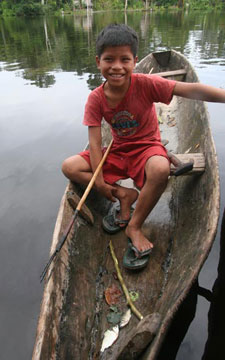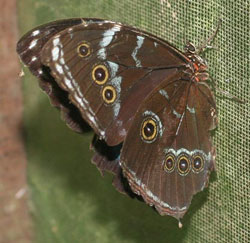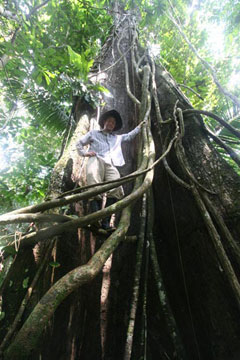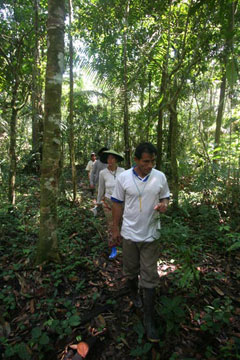Special to mongabay.com: Wilderness Classroom: Expedition 2006 The following is an update from The Wilderness Classroom’s expedition to the Peruvian rainforest. You can follow their adventures at wildernessclassroom.com |
Amazon rainforest: Empty of animals
The Wilderness Classroom Organization
May 3, 2006
Update 17: The friendly faces of Yarina – Dave
Yesterday afternoon, we started seeing other people plying the river in canoes, and we knew that our trip was about to change. We were getting close to Yarina, the first of three towns along the Yanayacu River. As we grew closer to town, we stopped hearing Howler Monkeys. The troops of Squirrel Monkeys we had grown accustomed to seeing were nowhere to be found. Within only a few hours we left the truly wild rainforest behind, entering a rainforest inhabited by people.
The last 4 days of our journey will be through populated areas, and we will be staying in communities along the river, rather than camping in the flooded forest. As we paddled into Yarina, I was saddened by the fact that it would be many months before I will wake up to the sound of howler monkeys. I have grown accustomed to using their guttural song as an alarm clock.
However, as soon as our boat touched shore, we were greeted by a dozen smiling children who looked at us shyly while we stepped out of our canoe. My thoughts of howler monkeys vanished, and I turned my attention towards the wonderful people of Yarina.
Within minutes, word spread that we were in town. Several people that remembered us from last year’s visit to Yarina came down to the river to say hello and to ask us how our year had gone. One boy came up and showed me a big scar on his foot, and thanked me for helping him. During last year’s Project Peru, he had cut is foot with a machete, and we had helped clean and bandage his wound.
 This young boy spent the morning spearing fish for his family. |
The children of Yarina are all very curious about us; there are always several kids, silently looking on as we cook, work on our computers, read, and go about our business. There are about 100 people that live in Yarina, and after a 10 minute walk around the community this morning, I had 18 children trailing along behind me.
We also went on a walk with a local man this morning to look for medicinal plants. The closest hospital to Yarina is in Nauta, which is a 10 hours away by motorboat. When people get sick in Yarina, they often rely on medicinal plants found in the surrounding forest to cure them. This morning we were introduced to over a dozen medicinal plants, which can be used to cure a wide range of ailments.
These people can teach us so much about the rainforest, I only wish we had more time.
Monday’s Daily Dilemma received many responses. Most of the Student Explorers told Anna to keep taking her malaria medication, despite its side effects. She will need to keep taking the medication for 4 weeks after returning to the United States. But, we all agree it’s better to be safe than sorry!
The March of the Leaf-Cutter Ants – Patrick
 Blue morpho butterfly |
Leaf-cutter ants are a serious threat to certain trees in the rainforest. During every hike we’ve taken- which is rare in the flooded forest- we’ve run into colonies of the industrious leaf-cutter ant. It is easy to see their well-worn path extending from the tree under attack leading back to the nest.
Life in Yarina – Anna
The underground nest, which is home to as many as five million ants, is an giant mound of exposed clay and mud. The nests can be up to one half acre large! Leaf pieces are cut with sharp mandibles, or small arms near the mouth, by the large worker ants. These workers are prone to attack by flies and wasps which try to lay deadly eggs on the ants while they’re transporting leaves. Because the ants’ mandibles are occupied with the leaf load, the worker cannot protect herself without dropping the leaf. So, a smaller leaf-cutter ant often rides on top of the leaf where they can challenge approaching danger and protect the carrier.
The special leaves which are cut and carried are not food for the colony. Instead, the leaves are cleaned, scraped and chewed into a mushy pulp. The pulp is then cultivates, or grows, a fungus. The fungus serves as the leaf-cutter ants’ staple food.
Apparently the leaf cutter ants cannot live without the fungus and the fungus cannot live without the ants. When the giant queen ant leaves the nest to start a new colony, she must take a mouthful of fungus to use as a starter for food in the new colony. Although there is just a single queen living in each colony, she produces thousands of princes and princesses every year. What’s more? The princes and princesses develop wings to fly far away from their birthplace. The flying hatchlings have very large abdomens which are a special treat to predators such as toucanets, nun birds, swallowtail kites, monkeys and even humans. How would you like a to eat a flying, fungus farming ant? Try saying that five times fast!
 Patrick scampered up this vine choked Kapok Tree to get a birds eye view of the surrounding forest. |
Yarina, a town of about 100 people and countless more chickens and ducks, has been my favorite stop so far. The village is beautiful, the people are kind, and the kids are a blast!
Since you wanted to learn more about what the kids do around here, I spent most of my time in Yarina with the children. It wasn’t difficult to do, since they have followed us around since the moment we woke up! The day started out early, when two girls stopped by to show us their beautiful homemade necklaces. They use colorful seeds from various trees in the rainforest, including the Yarina tree. Lorena and Marisol, ages 11 and 9, told me that after school they go into the woods to collect seeds for their necklaces. They spend many afternoons making their crafts, as well as helping their mothers prepare dinner. Preparing dinner includes cleaning and gutting fish and other meats. It might also mean sifting through rice and corn to remove rocks and bugs, just like we had to do with our quinoa. Their brothers spend the afternoons fishing and hunting for tapirs, monkeys, and peccaries, as well as swimming, and playing soccer.
Most children in Yarina wake up early to get chores done before school. Fourteen year old Edmin wakes up each morning at 6:00 to do his two very important chores. He collects water from the river and digs up yucca in the garden. Edmin walks a half an hour to his family’s garden to get the yucca.
 Anna, Warren, Patrick, and I joined a chief of Yarina for a walk in the forest to look for medicinal plants. |
The children of Yarina spend their weekends working and playing. The girls hand-wash the laundry with their mothers and help with cooking. The boys hunt and fish, and work in the family gardens. But there is plenty of time for play after the work gets done! On the weekends, the children of the community get together to play sports. Every Saturday they play a competitive game of volleyball. Every Sunday they play soccer. They also love to play tag and hide and seek. There are lots of good hiding places in the rainforest!
On Sundays, the kids in the community look forward to one thing that most of us take for granted. The adults turn on the town generator to create electricity, and everyone gathers around the one television in Yarina to watch a movie.
Spending time with the kids in Yarina has been fun for me. They are so creative and have taught me a lot about life in the rainforest. I look forward to meeting more children as we continue down the river.
Daily Dilemma #17: Where did all of the animals go?
As we begin to enter more communities nearing the end of the Yanayacu river, we are finding that there are fewer animals around. In fact, on our entire 10-hour paddle yesterday, we saw only two monkeys. We saw fewer birds than usual and only one Pink River Dolphin. The lack of animals is a sign that hunting is very common among these villages.
The people in the communities want more tourists to come to this area to help their economy. The more tourists, like us, that come through, the more food and supplies will be purchased in the towns. Additionally, when more people know about an area, there is more of an effort to protect it through education and money.
Most tourists visit the rainforest to see the exotic animals, especially the monkeys. If the community is hunting the monkeys, there are no monkeys for the tourists to see. Therefore, tourists will not want to visit this area. How do we express to the village people that if they want tourists to come through their villages, they must help restore the animal populations?
Track the adventurers at wildernessclassroom.com